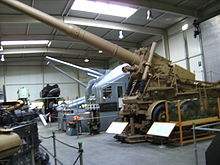Field gun
A field gun is a type of artillery cannon. In contrast to the mortar or howitzer, the field gun fires only in the lower angle group and is therefore a so-called flat trajectory gun.
Originally, field gun refers to a small gun that was intended to follow the infantry on the march and was mobile enough in battle to quickly change positions. This characteristic distinguished the field gun from the older guns, which were too large and cumbersome and were used only for sieges. For this reason, field guns belonged to field artillery, while heavy guns belonged to foot or fortress artillery. The forerunners of the field cannon were the field snakes.
Probably the most famous use of field cannons in terms of modern battle tactics was that of Gustavus Adolphus, who had large wheels mounted on the field cannons during the Thirty Years' War so that they could be moved quickly around the battlefield. This highly mobile use of the cannons during battle allowed closed enemy forces to be broken up, effectively reducing their engagement strength.
With the constant advancement of artillery, nearly all guns of every type were made mobile. Even the largest siege guns became rail guns or mobile on self-propelled mounts in the field during World War I. After the war, development shifted to highly mobile guns with correspondingly small calibers. However, the German Wehrmacht continued to have large-caliber guns in World War II, which were extremely ineffective.
In English, field guns are cannons with a caliber up to about 4.5 inches (114 mm). Larger were Medium and the large Heavy guns. The largest field gun was the BL 5.5 inch Medium Gun with a firing range of 14.6 km. In Germany, field guns were manufactured in calibers ranging from 75 to 140 mm.
The only Allied field gun other than the British 5.5-inch gun was the American 155 mm Gun M1 Long Tom. In Germany, compared to howitzers, very few field guns were produced before and even fewer during World War II, the exceptions being the 7.5-cm Field Cannon 16nA, the Heavy 10-cm Field Cannon 18 produced until 1945, and the 15-cm Cannon 39.
The class of small, highly mobile artillery systems up to 105 mm calibre has been largely replaced by the infantry's steep-fire guns (small mortars up to 120 mm calibre - grenade weapons). Howitzers in NATO caliber 155 mm or Russian caliber 152 mm in the form of an armored howitzer or as a self-propelled gun cover the medium range. Long-range weapons operations are carried out by missile weapons or combat aircraft.
In the Bundeswehr, machine guns such as the Rh 202 are also called field guns if they are made mobile and not installed as on-board weapons as in the Marder infantry fighting vehicle.

24-cm-cannon 3, military technical study collection Koblenz

A German 7.7 cm field gun 96 n.A. of the First World War
Questions and Answers
Q: What is a field gun?
A: A field gun is an artillery piece that can be quickly moved about the battlefield as needed.
Q: When was the term "field gun" first used and why?
A: The term "field gun" was first used to describe smaller guns that could be taken with an army while marching.
Q: Why were guns installed in a fort, siege cannon, and mortars not used in a battle?
A: Guns installed in a fort, siege cannon, and mortars were too large to be moved quickly and would be used only in a long siege.
Q: What kind of field guns did Napoleon use?
A: Napoleon used field guns with very large wheels that allowed them to be moved quickly even during a battle.
Q: How did moving the guns from place to place during the battle increase the overall effectiveness of the infantry?
A: By moving the guns from place to place during the battle, formations of enemy soldiers could be broken up to be handled by the infantry wherever they were massing, dramatically increasing the overall effectiveness of the infantry.
Q: What are some benefits of having a field gun on the battlefield?
A: Having a field gun on the battlefield allows for quick and flexible use of artillery, which can disrupt enemy formations and support friendly troops with cover fire.
Q: How does a field gun differ from other types of artillery?
A: A field gun is designed to be mobile and quickly moved about the battlefield as needed, while other types of artillery, such as those installed in a fort, are stationary and not easily moved during a battle.
Search within the encyclopedia